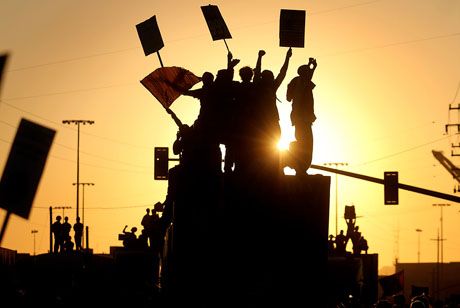Features
You are here
Sub-Saharan Africa: the year of revolt

April 14, 2012
2011 will be remembered as a historic year of revolt, with no signs of the global resistance abating in 2012. However, when talking about the incredible fightbacks that have rocked the world, seldom does that talk turn to sub-Saharan Africa; often it seems like resistance to austerity and repression stop in North Africa.
This is hardly the case and there are a number of extremely important fights that have been raging across Africa. These aren’t the armed, guerilla combat of impoverished child soldiers that Kony 2012 would promulgate. Rather, these are clashes of the African urban working class against their bosses and the state. The influence of the uprisings in Tunisia and Egypt go much farther than the Arab world and Occupy Wall Street.
Roughly a year ago, Botswana was shut down by its first-ever mass public sector strike. More than 90,000 government workers brought the country to a standstill for ten days. After only winning the legal right to strike a year prior, the Botswana Federation of Public Sector Unions—composed of government-employed doctors, nurses, cleaners, teachers and cooks—called the strike demanding a 16 per cent wage increase. The workers had been without a raise since 2008. This strike could be seen in a larger context, as the austerity and privatization that fuelled this struggle came from the advice of the International Monetary Fund (IMF), who reduced the size of the public sector and the public sector wages. The action featured mass solidarity strikes by secondary school students and clashes with the police.
2011 also saw demonstrators in Senegal force the president to retreat from a planned constitutional change that would have allowed him to stay in office for another term. In Burkina Faso, students protests against the police murder of a student turned into mass demonstrations that shook the government, including a revolt by presidential guards who had not been paid for months.
Uganda and Swaziland both saw anti-government protests. Two hundred thousand struck in South Africa and students demonstrated against poverty and inflation at the University of Kassala in Sudan.
Revolt continues
2012 has already seen incredible movement by the African working class. January saw a mass strike that shook Nigeria. Protesting against government plans to scrap the fuel subsidy, strikes and protests that brought up to ten million people out into the streets, shutting down most of Nigeria’s economy at a cost of $600 million a day. Despite the sellout of the struggle by the trade union leadership, this mass movement was able to wring concessions from the government and has offered opportunities for social forces to regroup and organize for the future.
In March, nurses in Kenya went out on strike for two weeks for better public services and wage increases. They showed incredible bravery, defying deals made between the union tops and governments and staring down the government’s decision to fire 25,000 nurses. They refused to go back to work until all of their fellow workers were reinstated.
Kenyan male and female sex workers marched in Nairobi’s central business districtdemanding an end to discrimination, police harassment and access to health, legal, medical and social services.
March also saw a one-day general strike in South Africa, the first in over ten years, that united organized and unorganized workers against labour brokers and increased road tolls. Two hundred thousand people marched in cities across the country, and mining, metal industry and retail stores were severely affected by the work stoppage.
These demonstrations show not only that the African working class is getting inspired, organized, and fighting back. It also is a sign of the times, showing how anti-austerity campaigns can be fought. As the demands of organized and unorganized workers for higher public sector wages and higher quality public services coalesce around a united fightback against employers and the state, the year of revolt continues, in Africa and beyond.
Section:
Topics:
- Log in to post comments










